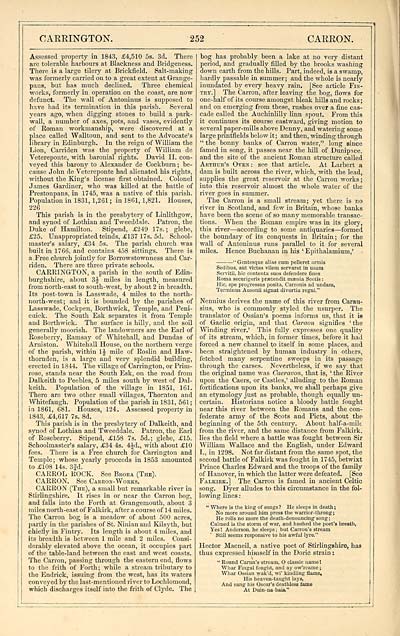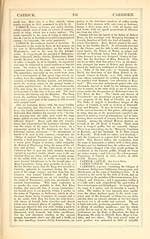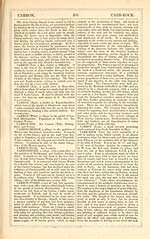Imperial gazeteer of Scotland, or, Dictionary of Scottish topography > Volume 1
(360) Page 252 - CAR
Download files
Complete book:
Individual page:
Thumbnail gallery: Grid view | List view

CARRINGTON.
252
CARRON.
Assessed property in 1843, £4,510 OS. 3d. There
are tolerable harbours at Blackness and Bridgeness.
There is a large tilery at Brickfield. Salt-making
was formerly carried on to a great extent at Grange-
pans, but has much declined. Three chemical
works, formerly in operation on the coast, are now
defunct. The wall of Antoninus is supposed to
have had its termination in this parish. Several
years ago, when digging stones to build a park-
wall, a number of axes, pots, and vases, evidently
of Roman workmanship, were discovered at a
place called Walltoun, and sent to the Advocate's
library in Edinburgh. In the reign of William the
Lion, Carriden was the property of William de
Vetereponte, with baronial rights. David II. con-
veyed this barony to Alexander de Cockburn ; be-
cause John de Vetereponte had alienated his rights,
without the King's license first obtained. Colonel
James Gardiner, who was killed at the battle of
Prestonpans, in 1745, was a native of this parish.
Population in 1831, 1,261 ; in 1861, 1,821. Houses,
226
This parish is in the presbytery of Linlithgow,
and synod of Lothian and Tweeddale. Patron, the
Duke of Hamilton. Stipend, £249 17s.; glebe,
£25. Unappropriated teinds, £137 17s. 5d. School-
master's salary, £34 5s. The parish church was
built in 1766, and contains 458 sittings. There is
a Free church jointly for Borrowstownness and Car-
riden. There are three private schools.
CAKPJNGTON, a parish in the south of Edin-
burghshire, about 3J miles in length, measured
from north-east to south-west, by about 2 in breadth.
Its post-town is Lasswade, 4 miles to the north-
north-west; and it is bounded by the parishes of
Lasswade, Cockpen, Borthwick, Temple, and Peni-
cuick. The South Esk separates it from Temple
and Borthwick. The surface is hilly, and the soil
generally moorish. The landowners are the Earl of
Roseberry, Ramsay of Whitehall, and Dundas of
Arniston. Whitehall House, on the northern verge
of the parish, within 1£ mile of Roslin and Haw-
thornden, is a large and very splendid building,
erected in 1344. The village of Carrington, or Prim-
rose, stands near the South Esk, on the road from
Dalkeith to Peebles, 5 miles south by west of Dal-
keith. Population of the village in 1851, 161.
There are two other small villages, Thornton and
Whitefaugh. Population of the parish in 1831, 561 ;
in 1861, 681. Houses, 124. Assessed property in
1843, £4,617 7s. 8d.
This parish is in the presbytery of Dalkeith, and
synod of Lothian and Tweeddale. Patron, the Earl
of Roseberry. Stipend, £158 7s. 5d.; glebe, £15.
Schoolmaster's salary, £34 4s. 4Jd., with about £10
fees. There is a Free church for Carrington and
Temple; whose yearly proceeds in 1853 amounted
to £108 14s. 3Jd.
CARROL ROCK. See Brora (The).
CARRON. See Carron- Works.
CARRON (The), a small but remarkable river in
Stirlingshire. It rises in or near the Carron bog,
and falls into the Forth at Grangemouth, about 3
miles north-east of Falkirk, after a course of 14 miles.
The Carron bog is a meadow of about 500 acres,
partly in the parishes of St. Ninian and Kilsyth, but
chiefly in Fintry. Its length is about 4 miles, and
its breadth is between 1 mile and 2 miles. Consi-
derably elevated above the ocean, it occupies part
of the table-land between the east and west coasts.
The Carron, passing through the eastern end, flows
to the frith of Forth; while a stream tributary to
the Endrick, issuing from the west, has its waters
conveyed by the last-mentioned river to Lochlomond,
which discharges itself into the frith of Clyde. The
bog has probably been a lake at no very distant
period, and gradually filled by the brooks washing
down earth from the hills. Part, indeed, is a swamp,
hardly passable in summer; and the whole is nearly
inundated by eveiy heavy rain. [See article Fin-
try.] The Carron, after leaving the bog, flows for
one-half of its course amongst bleak hills and rocks ;
and on emerging from these, rushes over a fine cas-
cade called the Auchinlilly linn spout. From this
it continues its course eastward, giving motion to
several paper-mills above Denny, and watering some
large printfields below it ; and then, winding through
"the bonny banks of Carron water," long since
famed in song, it passes near the hill of Dunipjce,
and the site of the ancient Roman structure called
Arthur's Oven: see that article. At Larbert a
dam is built across the river, which, with the lead,
supplies the great reservoir at the Carron works;
into this reservoir almost the whole water of the
river goes in summer.
The Carron is a small stream; yet there is no
river in Scotland, and few in Britain, whose banks
have been the scene of so many memorable transac-
tions. When the Roman empire was in its glory,
this river — according to some antiquaries — formed
the boundary of its conquests in Britain; for the
wall of Antoninus runs parallel to it for several
miles. Hence Buchanan in his ' Epithalamium,'
"Gentesque alias cum pelleret armis
Sedibus, aut victas vilem servaret in usum
Servitii, hie contenta suos defendere fines
Roma securigeris prajtendit maenia Scotis :
Hie, spe processus posita, Carronis ad undam,
Terminus Ausonii signat divortia regni."
Nennius derives the name of this river from Carau-
sius, who is commonly styled the usurper. The
translator of Ossian's poems informs us, that it is
of Gaelic origin, and that Caraon signifies 'the
Winding river.' This fully expresses one quality
of its stream, which, in former times, before it had
forced a new channel to itself in some places, and
been straightened by human industiy in others,
fetched many serpentine sweeps in its passage
through the carses. Nevertheless, if we say that
the original name was Caeravon, that is, ' the River
upon the Caers, or Castles,' alluding to the Roman
fortifications upon its banks, we shall perhaps give
an etymology just as probable, though equally un-
certain. Historians notice a bloody battle fought
near this river between the Romans and the con-
federate army of the Scots and Picts, about the
beginning of the 5th century. About half-a-mik
from the river, and the same distance from Falkirk,
lies the field where a battle was fought between Sir
William Wallace and the English, under Edward
I., in 1298. Not far distant from the same spot, the
second battle of Falkirk was fought in 1745, betwixt
Prince Charles Edward and the troops of the family
of Hanover, in which the latter were defeated. [See
Falkirk.] The Carron is famed in ancient Celtic
song. Dyer alludes to this circumstance in the fol-
lowing lines :
"Where is the king of songs? He sleeps in death;
No more around him press the warrior-throng;
He rolls no more the death-denouncing song;
Calmed is the storm of war, and hushed the poet's breath,
Yes ! Anderson, he sleeps ; but Carron's stream
' Still seems responsive to his awful lyre."
Hector Macneil, a native poet of Stirlingshire, has
thus expressed himself in the Doric strain :
" Round Carun's stream, O classic name 1
Whar Fingal fought, and ay ow'rcame ;
Whar Ossian wak'd, wi' kindling flame,
His heaven-taught lays,
And sang his Oscar's deathless fame
At Duin-na-bais."
252
CARRON.
Assessed property in 1843, £4,510 OS. 3d. There
are tolerable harbours at Blackness and Bridgeness.
There is a large tilery at Brickfield. Salt-making
was formerly carried on to a great extent at Grange-
pans, but has much declined. Three chemical
works, formerly in operation on the coast, are now
defunct. The wall of Antoninus is supposed to
have had its termination in this parish. Several
years ago, when digging stones to build a park-
wall, a number of axes, pots, and vases, evidently
of Roman workmanship, were discovered at a
place called Walltoun, and sent to the Advocate's
library in Edinburgh. In the reign of William the
Lion, Carriden was the property of William de
Vetereponte, with baronial rights. David II. con-
veyed this barony to Alexander de Cockburn ; be-
cause John de Vetereponte had alienated his rights,
without the King's license first obtained. Colonel
James Gardiner, who was killed at the battle of
Prestonpans, in 1745, was a native of this parish.
Population in 1831, 1,261 ; in 1861, 1,821. Houses,
226
This parish is in the presbytery of Linlithgow,
and synod of Lothian and Tweeddale. Patron, the
Duke of Hamilton. Stipend, £249 17s.; glebe,
£25. Unappropriated teinds, £137 17s. 5d. School-
master's salary, £34 5s. The parish church was
built in 1766, and contains 458 sittings. There is
a Free church jointly for Borrowstownness and Car-
riden. There are three private schools.
CAKPJNGTON, a parish in the south of Edin-
burghshire, about 3J miles in length, measured
from north-east to south-west, by about 2 in breadth.
Its post-town is Lasswade, 4 miles to the north-
north-west; and it is bounded by the parishes of
Lasswade, Cockpen, Borthwick, Temple, and Peni-
cuick. The South Esk separates it from Temple
and Borthwick. The surface is hilly, and the soil
generally moorish. The landowners are the Earl of
Roseberry, Ramsay of Whitehall, and Dundas of
Arniston. Whitehall House, on the northern verge
of the parish, within 1£ mile of Roslin and Haw-
thornden, is a large and very splendid building,
erected in 1344. The village of Carrington, or Prim-
rose, stands near the South Esk, on the road from
Dalkeith to Peebles, 5 miles south by west of Dal-
keith. Population of the village in 1851, 161.
There are two other small villages, Thornton and
Whitefaugh. Population of the parish in 1831, 561 ;
in 1861, 681. Houses, 124. Assessed property in
1843, £4,617 7s. 8d.
This parish is in the presbytery of Dalkeith, and
synod of Lothian and Tweeddale. Patron, the Earl
of Roseberry. Stipend, £158 7s. 5d.; glebe, £15.
Schoolmaster's salary, £34 4s. 4Jd., with about £10
fees. There is a Free church for Carrington and
Temple; whose yearly proceeds in 1853 amounted
to £108 14s. 3Jd.
CARROL ROCK. See Brora (The).
CARRON. See Carron- Works.
CARRON (The), a small but remarkable river in
Stirlingshire. It rises in or near the Carron bog,
and falls into the Forth at Grangemouth, about 3
miles north-east of Falkirk, after a course of 14 miles.
The Carron bog is a meadow of about 500 acres,
partly in the parishes of St. Ninian and Kilsyth, but
chiefly in Fintry. Its length is about 4 miles, and
its breadth is between 1 mile and 2 miles. Consi-
derably elevated above the ocean, it occupies part
of the table-land between the east and west coasts.
The Carron, passing through the eastern end, flows
to the frith of Forth; while a stream tributary to
the Endrick, issuing from the west, has its waters
conveyed by the last-mentioned river to Lochlomond,
which discharges itself into the frith of Clyde. The
bog has probably been a lake at no very distant
period, and gradually filled by the brooks washing
down earth from the hills. Part, indeed, is a swamp,
hardly passable in summer; and the whole is nearly
inundated by eveiy heavy rain. [See article Fin-
try.] The Carron, after leaving the bog, flows for
one-half of its course amongst bleak hills and rocks ;
and on emerging from these, rushes over a fine cas-
cade called the Auchinlilly linn spout. From this
it continues its course eastward, giving motion to
several paper-mills above Denny, and watering some
large printfields below it ; and then, winding through
"the bonny banks of Carron water," long since
famed in song, it passes near the hill of Dunipjce,
and the site of the ancient Roman structure called
Arthur's Oven: see that article. At Larbert a
dam is built across the river, which, with the lead,
supplies the great reservoir at the Carron works;
into this reservoir almost the whole water of the
river goes in summer.
The Carron is a small stream; yet there is no
river in Scotland, and few in Britain, whose banks
have been the scene of so many memorable transac-
tions. When the Roman empire was in its glory,
this river — according to some antiquaries — formed
the boundary of its conquests in Britain; for the
wall of Antoninus runs parallel to it for several
miles. Hence Buchanan in his ' Epithalamium,'
"Gentesque alias cum pelleret armis
Sedibus, aut victas vilem servaret in usum
Servitii, hie contenta suos defendere fines
Roma securigeris prajtendit maenia Scotis :
Hie, spe processus posita, Carronis ad undam,
Terminus Ausonii signat divortia regni."
Nennius derives the name of this river from Carau-
sius, who is commonly styled the usurper. The
translator of Ossian's poems informs us, that it is
of Gaelic origin, and that Caraon signifies 'the
Winding river.' This fully expresses one quality
of its stream, which, in former times, before it had
forced a new channel to itself in some places, and
been straightened by human industiy in others,
fetched many serpentine sweeps in its passage
through the carses. Nevertheless, if we say that
the original name was Caeravon, that is, ' the River
upon the Caers, or Castles,' alluding to the Roman
fortifications upon its banks, we shall perhaps give
an etymology just as probable, though equally un-
certain. Historians notice a bloody battle fought
near this river between the Romans and the con-
federate army of the Scots and Picts, about the
beginning of the 5th century. About half-a-mik
from the river, and the same distance from Falkirk,
lies the field where a battle was fought between Sir
William Wallace and the English, under Edward
I., in 1298. Not far distant from the same spot, the
second battle of Falkirk was fought in 1745, betwixt
Prince Charles Edward and the troops of the family
of Hanover, in which the latter were defeated. [See
Falkirk.] The Carron is famed in ancient Celtic
song. Dyer alludes to this circumstance in the fol-
lowing lines :
"Where is the king of songs? He sleeps in death;
No more around him press the warrior-throng;
He rolls no more the death-denouncing song;
Calmed is the storm of war, and hushed the poet's breath,
Yes ! Anderson, he sleeps ; but Carron's stream
' Still seems responsive to his awful lyre."
Hector Macneil, a native poet of Stirlingshire, has
thus expressed himself in the Doric strain :
" Round Carun's stream, O classic name 1
Whar Fingal fought, and ay ow'rcame ;
Whar Ossian wak'd, wi' kindling flame,
His heaven-taught lays,
And sang his Oscar's deathless fame
At Duin-na-bais."
Set display mode to: Large image | Transcription
Images and transcriptions on this page, including medium image downloads, may be used under the Creative Commons Attribution 4.0 International Licence unless otherwise stated. ![]()
| Gazetteers of Scotland, 1803-1901 > Imperial gazeteer of Scotland, or, Dictionary of Scottish topography > Volume 1 > (360) Page 252 - CAR |
|---|
| Permanent URL | https://digital.nls.uk/97463450 |
|---|
| Description | Volume I: Aan-Gordon. |
|---|---|
| Attribution and copyright: |
|

